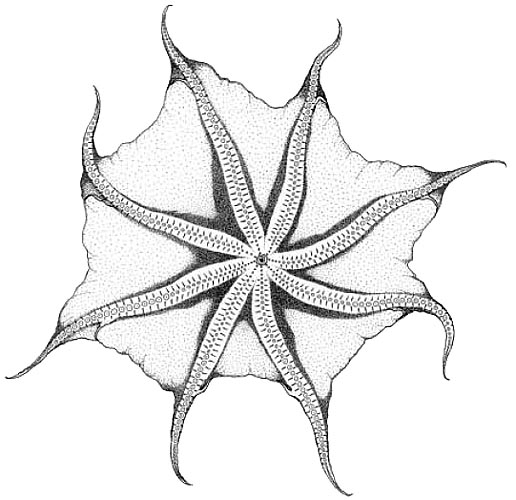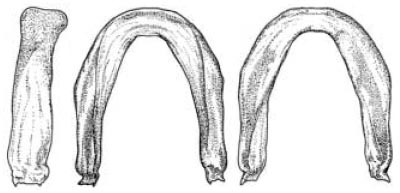Grimpoteuthis boylei
Martin Collins, Michael Vecchione, and Richard E. YoungIntroduction
Grimpoteuthis boylei is a large abyssal species described from the N. E. Atlantic from ten individuals.
Characteristics
- Arms and web
 Click on an image to view larger version & data in a new window
Click on an image to view larger version & data in a new window
Figure. Oral view of arms and web of G. boylei, paratype, female, 115 mm ML. Drawing from Collins (2003).
- Arms long, subequal in length.
- Web extends 2/3 of arm length; extends further on dorsal arms.
- Web formula: A>B>C>D>E.
- Single web nodule prominent on ventral side of each arm; located at sucker 31 (arm I), 28 (arm II), 25 (arm III) or 24 (arm IV).
- Sucker count 55-58.
- Maximum sucker diameter between suckers 25 and 35.
- Cirri long (mean CLI 12.2).
- First cirri between suckers 4 and 7.
- Shell
- U-shaped with distinct depression on outer surface of saddle.
- Inner surface of saddle convex.
- Lateral wing with blunt termination.
Comments
The above description is from Collins, 2003. More details of the description of G. boylei can be found here. The holotype is a 90 mm ML male.
Among other Atlantic species, Grimpoteuthis boylei differs in having a depression on the outer surface of the shell saddle. In addition it differs from:
- G. challengeri in the presence of posterior salivary glands, shape of the gills (broad rather than slender lamellae), egg size (18-20 mm vs 13 mm) and the number, form and arrangement of the suckers (Collins, 2003).
- G. discoveryi in the shape of the shell wing (wing ends in one vs two lobes), in the presence of a radula, in the presence of posterior salivary glands, in generally 8 vs 7 gill lamellae and the large size at maturity (265 vs 152 mm total length in females)(Collins, 2003).
- G. megaptera in geographic distribution (Eastern vs Western North Atlantic) and, perhaps, the larger sucker size (Collins, 2003).
- G. plena in geographic distribution (Eastern vs Western North Atlantic) and the longer cirri (ca. 2 vs 1.5x). What little is known about G. plena suggests that it is very close to G. boylei.(Collins, 2003).
- G. umbellata in the greater number of suckers (55-58 vs 65-68) and the greater depth range (>4000m vs <2500 m)(Collins, 2003).
- G. wuelkeri in longer cirri in females (2.2x vs 1.2x), fewer suckers (55-58 vs 60-70), generally 8 vs 6-7 gill lamellae, Shell without a ridge on the outer surface of the shell saddle, larger eggs (18-20 vs 14mm) and the greater depth range (>4000 vs <2100 m)(Collins, 2003).
Distribution
The type locality is the Porcupine Abyssal Plain at 48°47'N, 16°30'W; depth - 4845-4847 m. In addition to the type locality this species is known from the Porcupine Seabight and the Madeira Abyssal Plain but probably occurs from 20°N to 50°N in the NE Atlantic (Collins, 2002).
References
Collins, M. A. 2003. The genus Grimpoteuthis (Octopoda: Grimpoteuthidae) in the North-east Atlantic, with descriptions of three new species. Zool. Journ. Linnean Soc., 139: 93-127.
Title Illustrations

| Scientific Name | Grimpoteuthis boylei |
|---|---|
| Location | 50°N, 14°W |
| Reference | Collins, M. A. 2003. The genus Grimpoteuthis (Octopoda: Grimpoteuthidae) in the North-east Atlantic, with descriptions of three new species. Zool. Journ. Linnean Soc., 139: 93-127. |
| Sex | Female |
| View | Dorsal, ventral |
| Size | 440 mm TL |
| Type | Paratype |
| Copyright |
© Martin Collins

|
About This Page
Martin Collins

Aberdeen University, Aberdeen, UK

National Museum of Natural History, Washington, D. C. , USA

University of Hawaii, Honolulu, HI, USA
Page copyright © 2016 Martin Collins, , and
All Rights Reserved.
- First online 13 May 2003
Citing this page:
Collins, Martin, Michael Vecchione, and Richard E. Young. 2003. Grimpoteuthis boylei . Version 13 May 2003 (under construction). http://tolweb.org/Grimpoteuthis_boylei/20119/2003.05.13 in The Tree of Life Web Project, http://tolweb.org/











 Go to quick links
Go to quick search
Go to navigation for this section of the ToL site
Go to detailed links for the ToL site
Go to quick links
Go to quick search
Go to navigation for this section of the ToL site
Go to detailed links for the ToL site